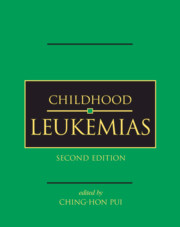Book contents
- Frontmatter
- Contents
- List of contributors
- Preface
- Part I History and general issues
- Part II Cell biology and pathobiology
- Part III Evaluation and treatment
- Part IV Complications and supportive care
- 29 Acute complications
- 30 Late complications after leukemia therapy
- 31 Therapy-related leukemias
- 32 Infectious disease complications in leukemia
- 33 Hematologic supportive care
- 34 Pain management
- 35 Psychosocial issues
- 36 Nursing care
- Index
- Plate Section between pages 400 and 401
- References
31 - Therapy-related leukemias
from Part IV - Complications and supportive care
Published online by Cambridge University Press: 01 July 2010
- Frontmatter
- Contents
- List of contributors
- Preface
- Part I History and general issues
- Part II Cell biology and pathobiology
- Part III Evaluation and treatment
- Part IV Complications and supportive care
- 29 Acute complications
- 30 Late complications after leukemia therapy
- 31 Therapy-related leukemias
- 32 Infectious disease complications in leukemia
- 33 Hematologic supportive care
- 34 Pain management
- 35 Psychosocial issues
- 36 Nursing care
- Index
- Plate Section between pages 400 and 401
- References
Summary
Introduction
The estimated frequency of second cancers in long-term survivors of primary cancers is about 7%. Although leukemias comprise only a small fraction of all second cancers, they are the major second cancers resulting from chemotherapy. The two broad classes of cytotoxic drugs associated with leukemia are alkylating agents and DNA topoisomerase II inhibitors. This chapter will focus on the features that distinguish alkylating agent-related leukemias and DNA topoisomerase II inhibitor-related leukemias as the two major forms of leukemia attributed to chemotherapy. Chemotherapy has been implicated in acute myelogenous leukemia (AML) of virtually all morphologic subtypes, myelodysplastic syndrome (MDS), acute lymphoblastic leukemia (ALL) and chronic myelogenous leukemia (CML) (reviewed in Felix). By contrast, therapeutic radiation primarily induces solid tumors, but also has been linked to an increased risk of leukemia. There are many more reports of chemotherapy-related leukemias in adults than in children; however, leukemia has become an increasingly important complication of cytotoxic chemotherapy in children because they are more likely than adults to survive their primary cancers.
Epidemiology of treatment-related leukemias
Alkylating agent-related leukemias: incidence and risk
A minority of patients (40% in one large series) who develop therapy-related leukemia have received chemotherapy alone, and there is often overlap between alkylating agents and DNA topoisomerase II inhibitors in the chemotherapy regimen. The first observations of alkylating agent-related leukemia and MDS were reported in about 1970. Therapy-related MDS and AML can occur after administration of virtually all of the many different alkylating agents.
- Type
- Chapter
- Information
- Childhood Leukemias , pp. 774 - 804Publisher: Cambridge University PressPrint publication year: 2006
References
- 1
- Cited by



